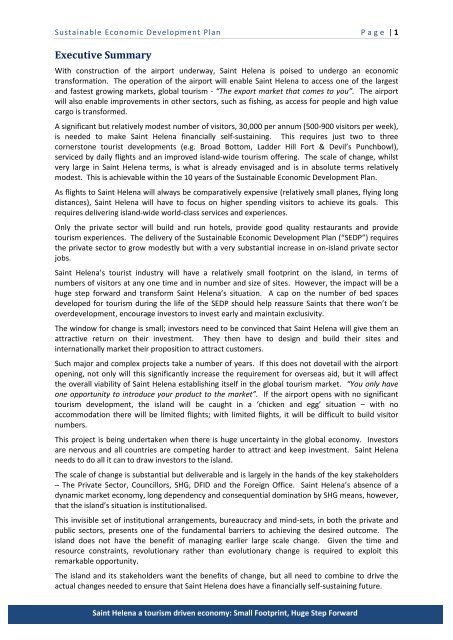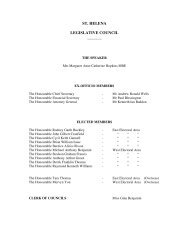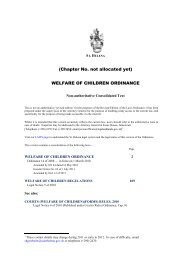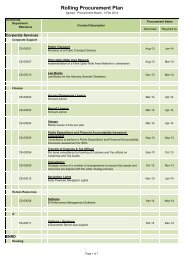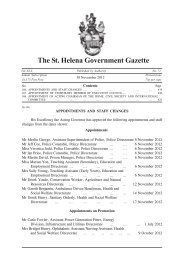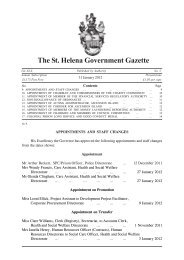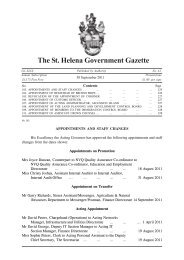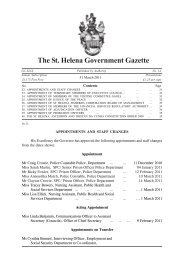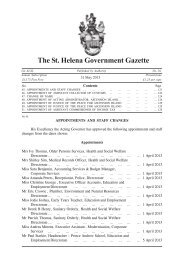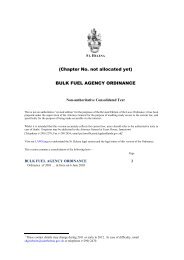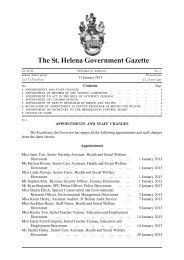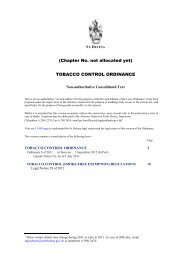Sustainable Economic Development Plan 2012/13 - St Helena
Sustainable Economic Development Plan 2012/13 - St Helena
Sustainable Economic Development Plan 2012/13 - St Helena
You also want an ePaper? Increase the reach of your titles
YUMPU automatically turns print PDFs into web optimized ePapers that Google loves.
<strong>Sustainable</strong> <strong>Economic</strong> <strong>Development</strong> <strong>Plan</strong> P a g e | 1<br />
Executive Summary<br />
With construction of the airport underway, Saint <strong>Helena</strong> is poised to undergo an economic<br />
transformation. The operation of the airport will enable Saint <strong>Helena</strong> to access one of the largest<br />
and fastest growing markets, global tourism - “The export market that comes to you”. The airport<br />
will also enable improvements in other sectors, such as fishing, as access for people and high value<br />
cargo is transformed.<br />
A significant but relatively modest number of visitors, 30,000 per annum (500-900 visitors per week),<br />
is needed to make Saint <strong>Helena</strong> financially self-sustaining. This requires just two to three<br />
cornerstone tourist developments (e.g. Broad Bottom, Ladder Hill Fort & Devil’s Punchbowl),<br />
serviced by daily flights and an improved island-wide tourism offering. The scale of change, whilst<br />
very large in Saint <strong>Helena</strong> terms, is what is already envisaged and is in absolute terms relatively<br />
modest. This is achievable within the 10 years of the <strong>Sustainable</strong> <strong>Economic</strong> <strong>Development</strong> <strong>Plan</strong>.<br />
As flights to Saint <strong>Helena</strong> will always be comparatively expensive (relatively small planes, flying long<br />
distances), Saint <strong>Helena</strong> will have to focus on higher spending visitors to achieve its goals. This<br />
requires delivering island-wide world-class services and experiences.<br />
Only the private sector will build and run hotels, provide good quality restaurants and provide<br />
tourism experiences. The delivery of the <strong>Sustainable</strong> <strong>Economic</strong> <strong>Development</strong> <strong>Plan</strong> (“SEDP”) requires<br />
the private sector to grow modestly but with a very substantial increase in on-island private sector<br />
jobs.<br />
Saint <strong>Helena</strong>’s tourist industry will have a relatively small footprint on the island, in terms of<br />
numbers of visitors at any one time and in number and size of sites. However, the impact will be a<br />
huge step forward and transform Saint <strong>Helena</strong>’s situation. A cap on the number of bed spaces<br />
developed for tourism during the life of the SEDP should help reassure Saints that there won’t be<br />
overdevelopment, encourage investors to invest early and maintain exclusivity.<br />
The window for change is small; investors need to be convinced that Saint <strong>Helena</strong> will give them an<br />
attractive return on their investment. They then have to design and build their sites and<br />
internationally market their proposition to attract customers.<br />
Such major and complex projects take a number of years. If this does not dovetail with the airport<br />
opening, not only will this significantly increase the requirement for overseas aid, but it will affect<br />
the overall viability of Saint <strong>Helena</strong> establishing itself in the global tourism market. “You only have<br />
one opportunity to introduce your product to the market”. If the airport opens with no significant<br />
tourism development, the island will be caught in a ‘chicken and egg’ situation – with no<br />
accommodation there will be limited flights; with limited flights, it will be difficult to build visitor<br />
numbers.<br />
This project is being undertaken when there is huge uncertainty in the global economy. Investors<br />
are nervous and all countries are competing harder to attract and keep investment. Saint <strong>Helena</strong><br />
needs to do all it can to draw investors to the island.<br />
The scale of change is substantial but deliverable and is largely in the hands of the key stakeholders<br />
– The Private Sector, Councillors, SHG, DFID and the Foreign Office. Saint <strong>Helena</strong>’s absence of a<br />
dynamic market economy, long dependency and consequential domination by SHG means, however,<br />
that the island’s situation is institutionalised.<br />
This invisible set of institutional arrangements, bureaucracy and mind-sets, in both the private and<br />
public sectors, presents one of the fundamental barriers to achieving the desired outcome. The<br />
island does not have the benefit of managing earlier large scale change. Given the time and<br />
resource constraints, revolutionary rather than evolutionary change is required to exploit this<br />
remarkable opportunity.<br />
The island and its stakeholders want the benefits of change, but all need to combine to drive the<br />
actual changes needed to ensure that Saint <strong>Helena</strong> does have a financially self-sustaining future.<br />
Saint <strong>Helena</strong> a tourism driven economy: Small Footprint, Huge <strong>St</strong>ep Forward


